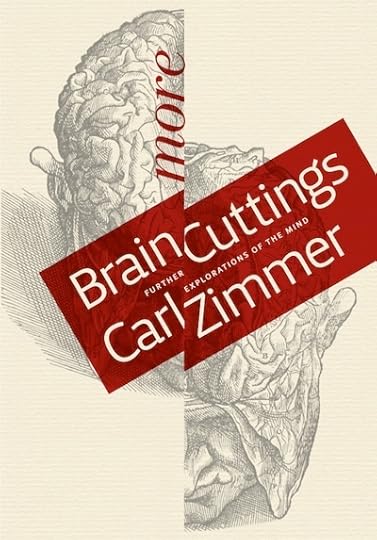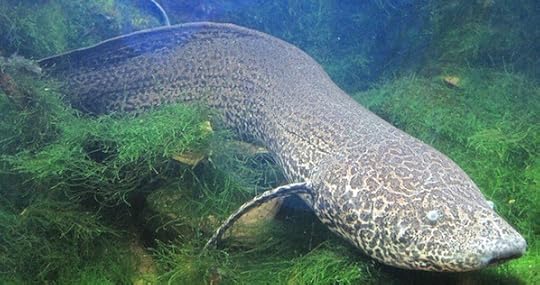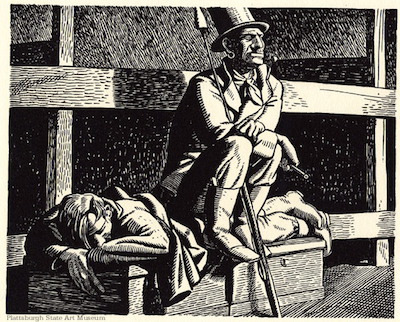Carl Zimmer's Blog, page 53
December 20, 2011
Melville and microbes: An interview about science writing with Eric Michael Johnson
Eric Michael Johnson, an historian of science, is also the writer behind an excellent blog, "The Primate Diaries." The other day he gave me a call to talk about science writing. He put together a two-part Q&A that he published today (part one and part two) that ranges from the science writing in Moby Dick to the microscopic virtues of Twitter. I was particularly flattered to get a portrait done by Nathaniel Gold. Check it out!

Should the new flu stay secret? Or does secrecy kill?
 Recently I blogged about a new strain of potentially dangerous flu that evolved during experiments in the Netherlands and Wisconsin. There I tried to counter the misconception that scientists had intentionally concocted this particular strain. Because these new flus actually evolved pretty quickly in laboratories, we now know we should take seriously the possibility that this transformation may happen in the outside world someday.
Recently I blogged about a new strain of potentially dangerous flu that evolved during experiments in the Netherlands and Wisconsin. There I tried to counter the misconception that scientists had intentionally concocted this particular strain. Because these new flus actually evolved pretty quickly in laboratories, we now know we should take seriously the possibility that this transformation may happen in the outside world someday.
But there's a second issue at play with this new virus: should the world get to see its genome?
As Martin Enserink reported last month, both teams of scientists have submitted their papers for publication. Normally, such a paper might include the entire genome of the new viruses. This was a touchy subject, so the papers went under review by the U.S. National Science Advisory Board for Biosecurity (NSABB).
Today, the editors at Science passed on the NSABB's reccommendations. I'll quote them here in full:
The National Science Advisory Board for Biosecurity (NSABB) made the following
recommendations regarding the publication of two manuscripts on highly pathogenic avian
influenza A/H5N1:
1. Neither manuscript should be published with complete data and experimental details.
December 19, 2011
The French Disease, the Italian Disease, the Christian Disease–the New World Disease?

In 1494, King Charles VIII of France invaded Italy. Within months, his army collapsed and fled. It was routed not by the Italian army but by a microbe. A mysterious new disease spread through sex killed many of Charles's soldiers and left survivors weak and disfigured. French soldiers spread the disease across much of Europe, and then it moved into Africa and Asia. Many called it the French disease. The French called it the Italian disease. Arabs called it the Christian disease. Today, it is called syphilis.
I've been intrigued by the murky history of syphilis for a few years now. The text above is from the start of an article I wrote for Science in 2008. At the time, scientists were split between two explanations for sudden appearance of syphilis at the end of the fifteenth century. According to one, it was caused by bacteria that had evolved in the New World and was brought back to Europe by Columbus's crew. But other researchers found many skeletons with signs of syphilis in Europe, Africa, and Asia that appeared to have been from long before Columbus's voyage.
As I explained in the article, ...

December 15, 2011
When Sight Shapes Sound (And Vice Versa)
We take in streams of information of radically different forms: photons through the eyes, textures through the skin, air vibrations through the ears, molecules through the nose. Marvelously, we manage to integrate all that information into a unified, coherent feel of the world. It turns out that as we draw in these different streams, we use information from one sense to shape what we take in from others. It's an efficient way to make the most of our imperfect perceptions. But it also leaves us vulnerable to some remarkable illusions, like the one illustrated in this video.
In my latest column for Discover, I explore our powers of multi-sensory integration. Check it out.

Presenting a new ebook: More Brain Cuttings
 Last year I decided to play in the ebook sandbox. I brought together some of my favorite pieces about the brain in an anthology I entitled Brain Cuttings: Fifteen Journeys Through the Mind. I teamed up with the daring design duo of George Scott and Charles Nix, and we produced an ebook.
Last year I decided to play in the ebook sandbox. I brought together some of my favorite pieces about the brain in an anthology I entitled Brain Cuttings: Fifteen Journeys Through the Mind. I teamed up with the daring design duo of George Scott and Charles Nix, and we produced an ebook.
Along the way, we learned a lot. I recounted some of the lessons in this piece for the Atlantic, and others in this conversation with the writer Steve Silberman. Suffice to say, publishing ebooks is by no means a frictionless utopia for writers. Nevertheless it remains strangely addictive. Perhaps we writers get the same jolt of dopamine that readers get when they tap a glass screen and are rewarded with a new book.
It just so happens I now have some new material to keep fueling my addition. I've continued to write about the brain, and recently I selected another crop of favorites. This new ebook has made it down the digital assembly line, and is now available for $7.99: More Brain Cuttings: Further Exporations of the Mind (Amazon, Barnes & Noble).
You'll find a ...

December 12, 2011
A Long Walk To Land
 Long before Darwin published The Origin of Species, there was talk of evolution. The more acquainted naturalists became with the major groups of animals, the gaps between them grew smaller. Once it seemed as if mammals were profoundly different than other vertebrates, for example. And then European explorers encountered the platypus, a mammal that laid eggs. Perhaps the major groups of animals had not been separately created, some naturalists suggested. Perhaps life had changed over time.
Long before Darwin published The Origin of Species, there was talk of evolution. The more acquainted naturalists became with the major groups of animals, the gaps between them grew smaller. Once it seemed as if mammals were profoundly different than other vertebrates, for example. And then European explorers encountered the platypus, a mammal that laid eggs. Perhaps the major groups of animals had not been separately created, some naturalists suggested. Perhaps life had changed over time.
In 1837, a profoundly paradoxical creature was shipped from West Africa to London, packed in clay. It was destined for Richard Owen, the greatest British anatomist of his age. He picked away the clay, to reveal a creature that looked like a fish. It has a knife-shaped body, gills, and fins. "If indeed the species had been known only by its skeleton," Owen wrote, "no one could have hesitated in referring it to the class of Fishes."
But inside its body, Owen found what he could only call lungs. Its whisker-like fins had a chains of bones that faintly resembled arms. Owen was a fierce opponent of all the transformationists of his day, and ...

December 10, 2011
The Science Ink of Moby Dick
 I've been doing some research on the long cultural history of tattoos in preparation for my talk about Science Ink at Harvard on Tuesday. I'm a hard-core Moby Dick fan (this blog's name comes from there), so it was a delight to stumble across a passage on tattoos, which I had forgotten.
I've been doing some research on the long cultural history of tattoos in preparation for my talk about Science Ink at Harvard on Tuesday. I'm a hard-core Moby Dick fan (this blog's name comes from there), so it was a delight to stumble across a passage on tattoos, which I had forgotten.
Queequeg, readers may recall, was covered with tattoos. Here's how Ishmael describes them:
This tattooing had been the work of a departed prophet and seer of his island, who, by those hieroglyphic marks, had written out on his body a complete theory of the heavens and the earth, and a mystical treatise on the art of attaining truth; so that Queequeg in his own proper person was a riddle to unfold; a wondrous work in one volume; but whose mysteries not even himself could read, though his own live heart beat against them; and these mysteries were therefore destined in the end to moulder away with the living parchment whereon they were inscribed, and so be unsolved to the last.
[Image: Rockwell Kent, Plattsburgh State Art Museum]

December 4, 2011
Do you own your germs? My new piece for the New York Times on micro-bioethics

There are 100 trillion microbes that live in your body. Do you own them? Do they deserve the same protections as your own genes and cells? If someone genetically alters a microbe and claims that if you swallow it, it will let you lose weight, should that living germ be regulated as a drug?
These are a few of the questions I mull in a piece that appears in the Sunday Review section of today's New York Times. I've been writing a lot about the microbial world for a few years now, but only recently did I encounter a group of bioethicists who are now pondering what sort of ground rules we should set up to govern science and medicine as we gain understanding and power over the microbiome. Check it out.
If you're interested in reading more about all this, here are a few new papers (some free, some behind paywalls).
The Human Microbiome Project: lessons from human genomics: Trends in Microbiology (in press)
December 2, 2011
#scienceink round-up: Der Spiegel, The Toronto Star, and more

It's been a busy week for Science Ink!
1. Science Ink was on TV. The Daily Planet, a Canadian science news show on the Discovery Channel, interviewed me about my favorite tattoos.
2.The Irish Times put Science Ink on top of its list of science books for holiday gifts. (As did MSNBC and io9.)
3. Der Spiegel takes a look.
4. The Toronto Star has a whole package on Science Ink in Saturday's issue: A Q&A with yours truly, an article by Megan Ogilvie about Toronto-area scientists with tattoos, and a slide show of their tattoos. (I was amazed that there were lots of tattoos I had never seen before!)
5. Just a reminder to folks in Boston: I will be giving a lecture at the Harvard Museum of Natural History on Tuesday, 12/13 at 6 pm. The lecture is free and open to the public. (The parking is free too!) Details are here.
[This tattoo of cyanide is from David Lighthart.]

Happy Birthday, #arseniclife

Today marks the one-year anniversary of the Arsenic Life Affair. On December 2, 2010, NASA-funded scientists announced that they had discovered a microbe in Mono Lake that broke the rules of biology. They claimed it could build DNA from arsenic rather than phosophorus. It was a sensational claim, and it was greeted by a spectacular backlash.
Alan Boyle takes a close look at arsenic life on its first birthday over at MSNBC. Other scientists have yet to report whether they can replicate the results or not (the bet of many experts is on not). Meanwhile, other researchers are studying its biology, sequencing its genome, and otherwise investigating it as they would any new microbe. It seems as if the arsenic life affair is morphing into regular science. Which may be about as good of an ending as one could hope.
The year has been an intriguing one for me as a journalist–I've found writing about arsenic life as both science and the sociology of science to be very satisfying. Here's a round-up of my main pieces:
1.Of Arsenic and Aliens, The Loom, 12/2/10
This was the first post I wrote, on the day ...




















